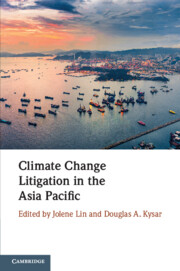Book contents
- Climate Change Litigation in the Asia Pacific
- Climate Change Litigation in the Asia Pacific
- Copyright page
- Contents
- Figures
- Tables
- Contributors
- Foreword
- Abbreviations
- Introduction
- Part I Theoretical Underpinnings and Implications of Climate Change Litigation
- Part II International Law and International Adjudication
- Part III Domestic Law and Domestic Adjudication
- Part IV China, Courts and Climate Change
- 12 Climate Change Litigation: A Promising Pathway to Climate Justice in China?
- 13 The Subordinate and Passive Position of Chinese Courts in Environmental Governance
- 14 Tort-Based Public Interest Litigation on Air Pollution in China: A Promising Pathway for Chinese Climate Change Litigation?
- Index
13 - The Subordinate and Passive Position of Chinese Courts in Environmental Governance
from Part IV - China, Courts and Climate Change
Published online by Cambridge University Press: 06 November 2020
- Climate Change Litigation in the Asia Pacific
- Climate Change Litigation in the Asia Pacific
- Copyright page
- Contents
- Figures
- Tables
- Contributors
- Foreword
- Abbreviations
- Introduction
- Part I Theoretical Underpinnings and Implications of Climate Change Litigation
- Part II International Law and International Adjudication
- Part III Domestic Law and Domestic Adjudication
- Part IV China, Courts and Climate Change
- 12 Climate Change Litigation: A Promising Pathway to Climate Justice in China?
- 13 The Subordinate and Passive Position of Chinese Courts in Environmental Governance
- 14 Tort-Based Public Interest Litigation on Air Pollution in China: A Promising Pathway for Chinese Climate Change Litigation?
- Index
Summary
This chapter takes an in-depth understanding of the role played by Chinese courts in environmental governance over the past decades as a starting point to discussions about whether there exists a possibility of introducing climate change litigation in China. The chapter is therefore not focused on examining the feasibility of climate change litigation in Chinese courts, but on the role and inadequacies of courts in environmental and ecological protection. Such an exploration will undoubtedly be invaluable in determining the future possibility of Chinese courts as drivers of climate change litigation. The chapter adopts an empirical approach, drawing upon official resources and case analysis to highlight the dominance of administrative punishment and the inability of Chinese courts to provide victims with effective or meaningful relief, given that, in litigation, the number of criminal cases far eclipses civil ones. The chapter also seeks to argue that the judiciary does not have policy-making functions in China and environmental public interest litigation faces significant challenges.
Keywords
- Type
- Chapter
- Information
- Climate Change Litigation in the Asia Pacific , pp. 365 - 393Publisher: Cambridge University PressPrint publication year: 2020



